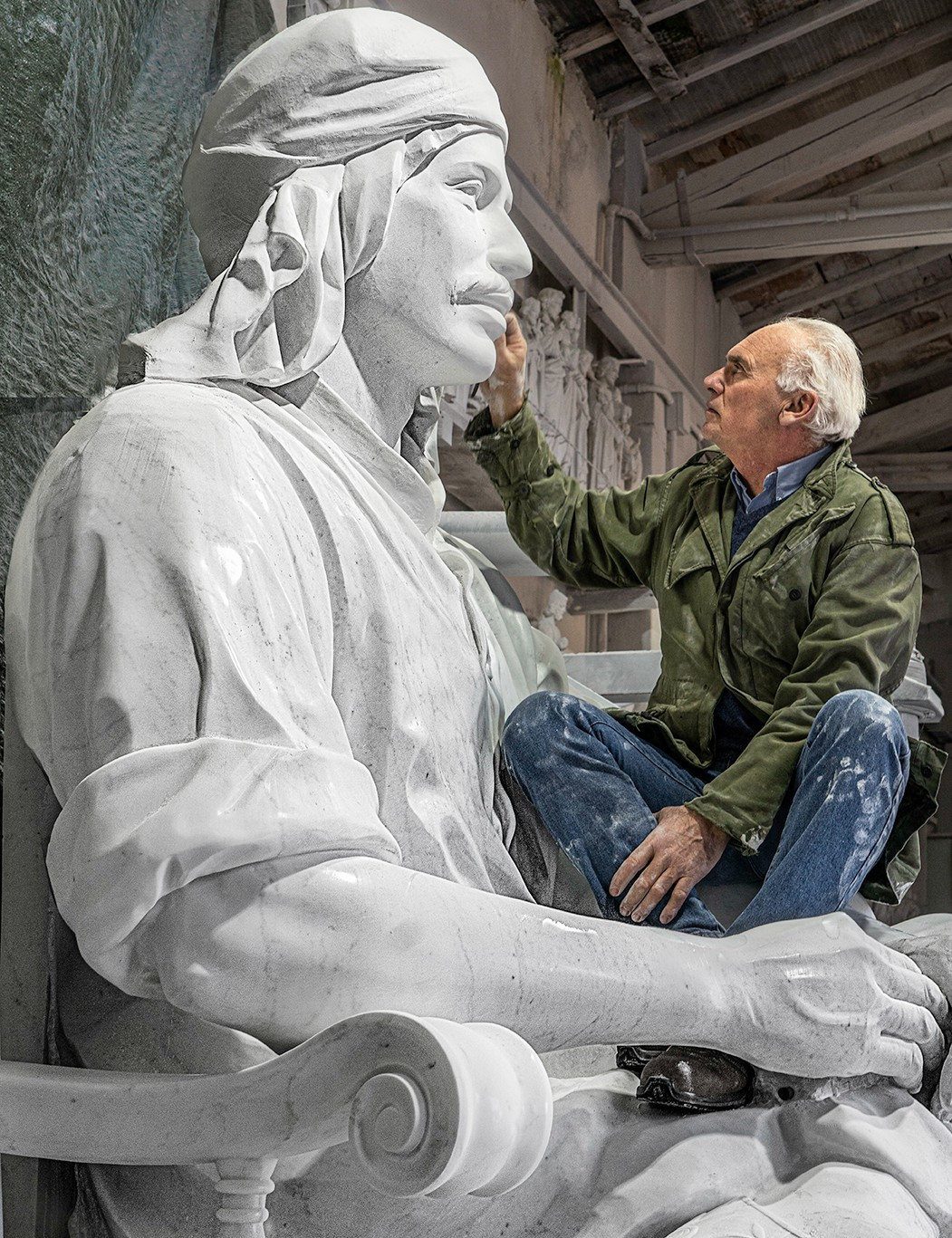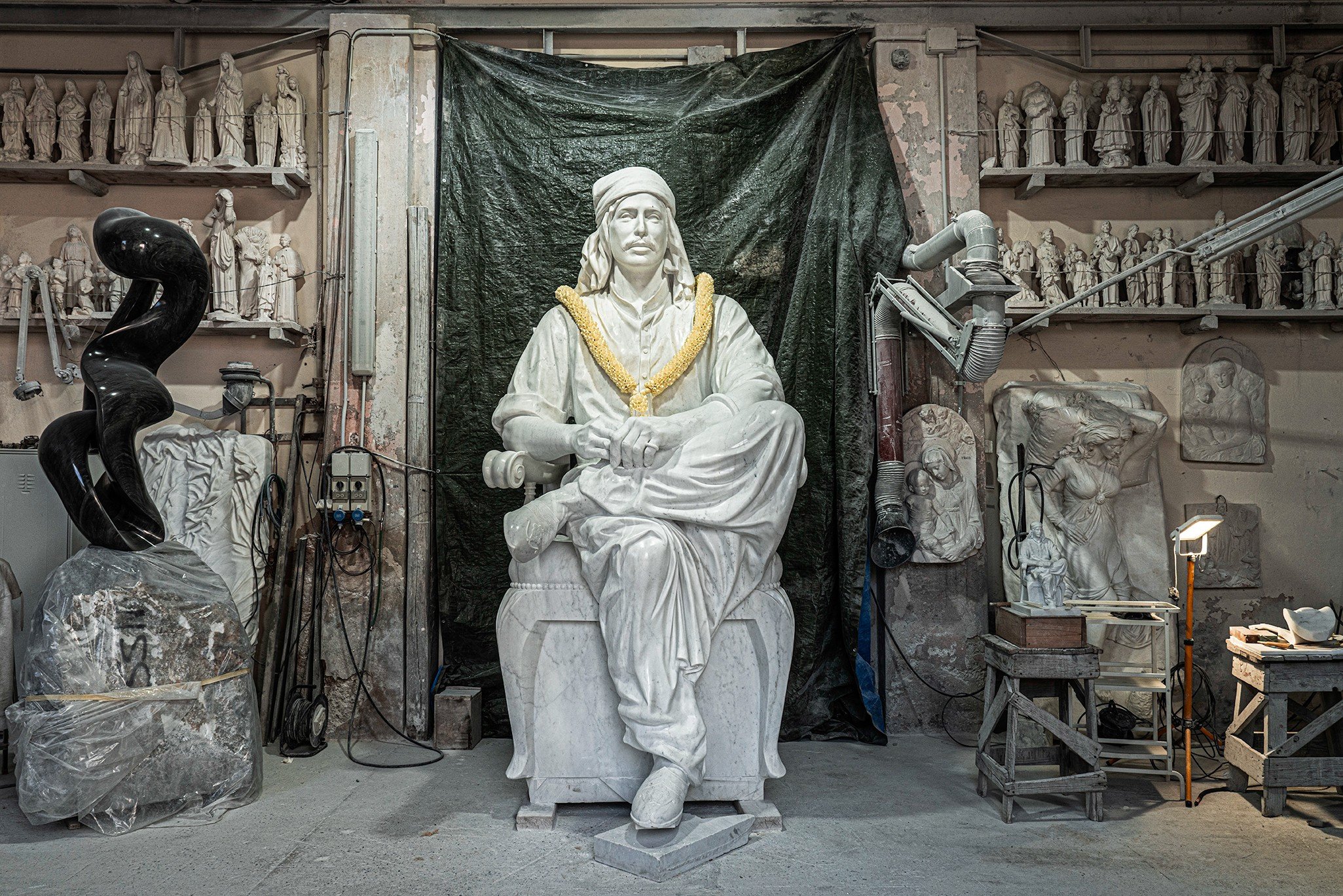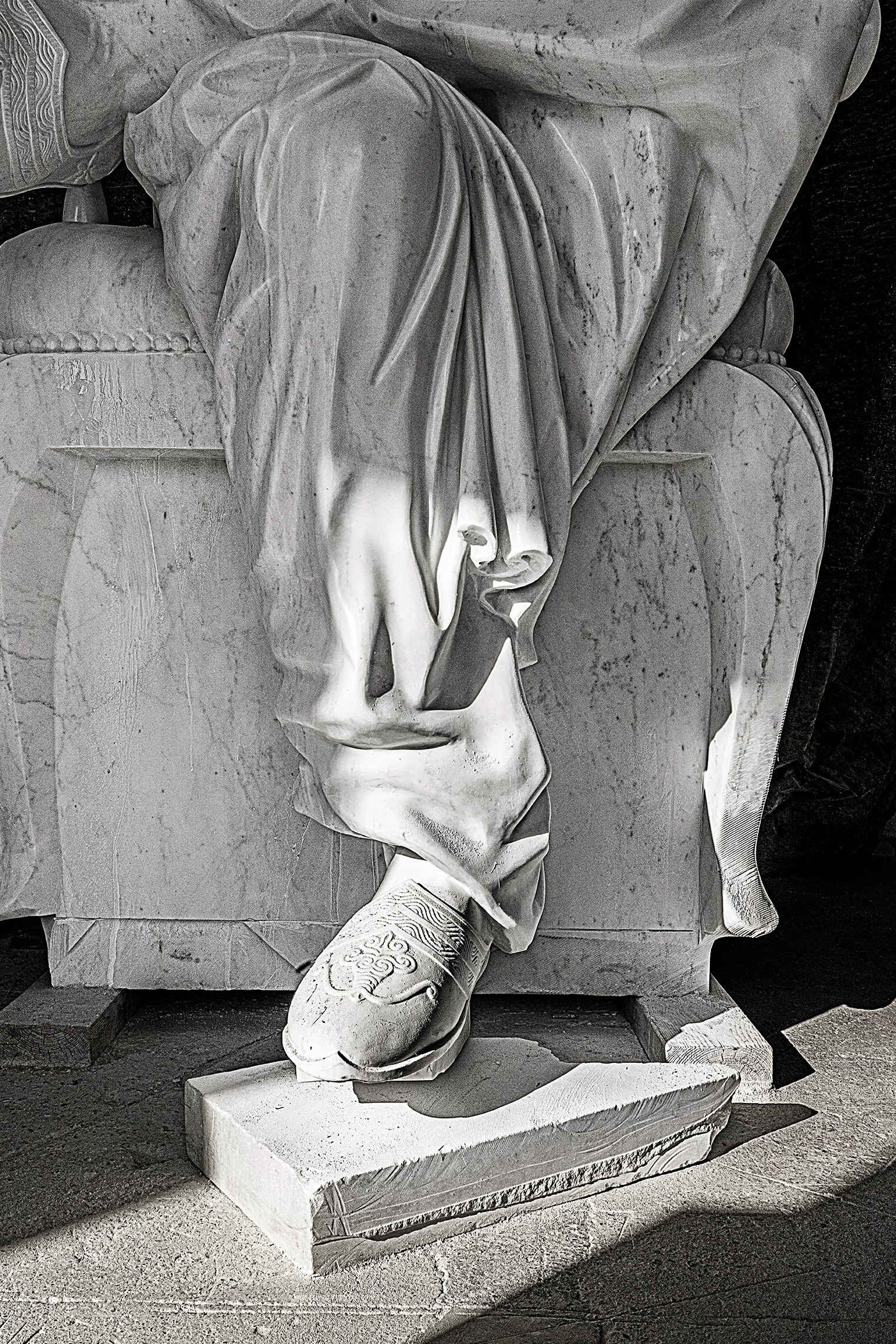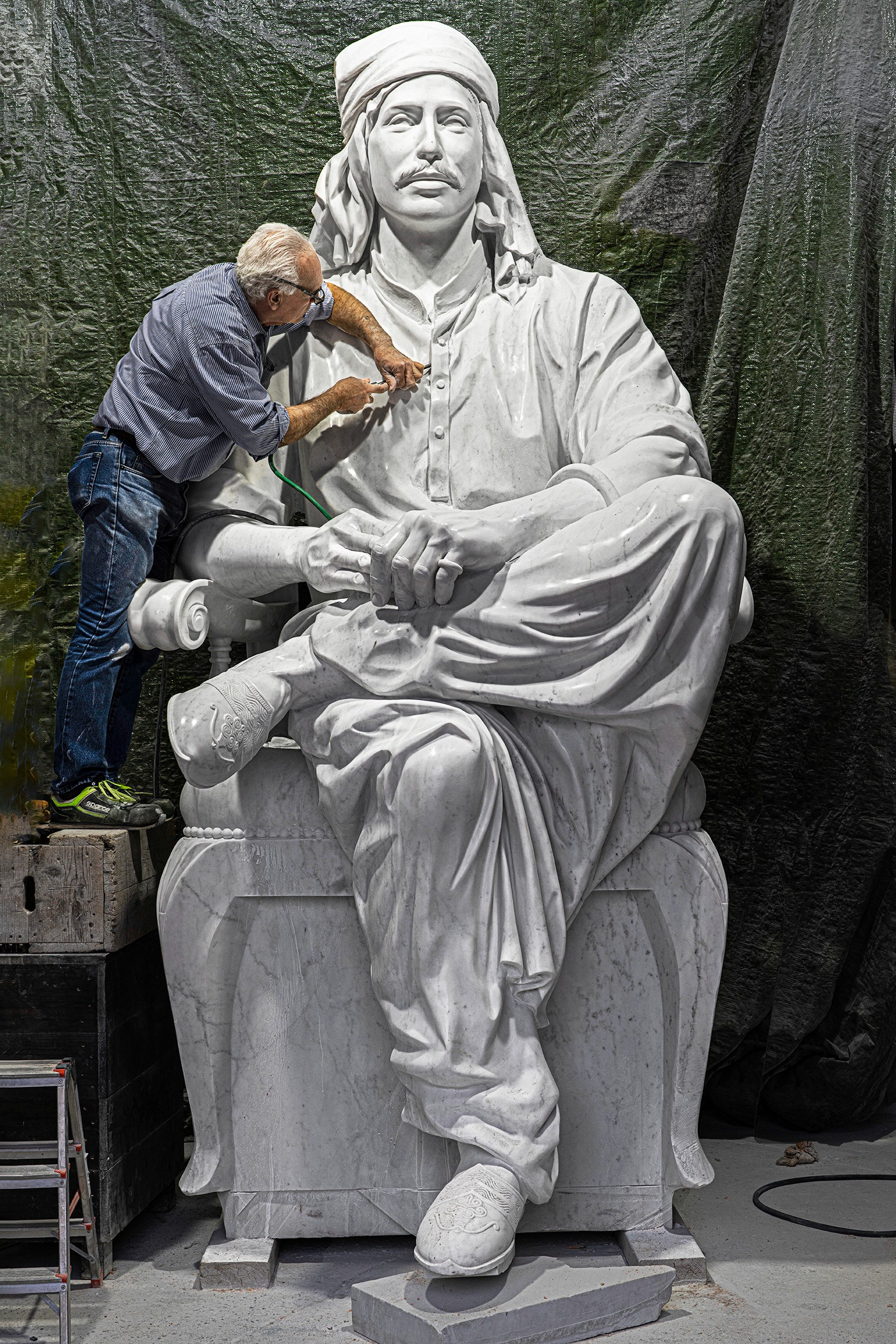
Nicola Stagetti working on Pramashwar the Infinite
This is the story behind the creation of a modern day Indian saint, Pramashwar the Infinite.
Artisan and studio head Nicola Stagetti spoke to us from his studios, where historic busts line the shelves and the familiar roar of his robot emanates from the next room. Nicola completed his art education in Pietrasanta and went on to become an apprentice in his father’s workshop, then called Stagetti & Cosci. In 1996 he changed the company name to Marble Studio Stagetti.

Pramashwar the Infinite, 2022
Nicola approached this project with great passion. He talks about the joys and challenges of realising this piece, a representation of an Indian holy saint with huge significance for many of his followers. Nicola has been working on the project for the past three years from just one original photograph of the saint who lived in India 100 years ago.


Robin Sethi, the project co-ordinator from India, met us in the gardens of the Convent of San Francesco, which dates back to the 16th century and was once dedicated to prayer and meditation, but now offers community courses, internships and puts on conferences, all in the area of the arts.
He talks of his admiration for how Nicola skillfully replicated in marble the shoes that the saint wore. The original shoes were handcrafted in leather with fine thread work.

All photos by Gail Skoff: gailskoff.com – instagram.com/skoffupclose
Links
For Pramashwar the Infinite, visit Yogiraj Sarkar Godariwale Trust at ysgt.org
Credits
Producer: Sarah Monk
Producer/editor: Mike Axinn
Music: courtesy of Audio Network
Monsoon Yaman, Pete Lockett
They say that you have to come in India to see the place where this work is gonna be. When I landed in Delhi and I come off the gate, there was 20 people with flowers to wait me. And it was 02:00 in the night and I was very impressed. Just like that, I knew that I was inside a competition.
Sarah Monk:Hi. This is Sarah with another episode of Materially Speaking, where artists and artisans tell their stories through the materials they choose. Today, Mike Akson and I are hearing the story behind the creation of a modern day Indian saint, Pramashwadi Infinite, from the esteemed artisan Nicola Stagetti of Stagetti Studios in Pietrasanta and Robin Sethi, the project coordinator from India. Nicola spoke to us in his studios where historic busts line the shelves and the familiar roar of his robot emanates from the next room. Robin met us in the gardens of the convent of San Francesco, which dates back to the sixteenth century and was once dedicated to prayer and meditation, but now offers community courses, conferences and internships, all in the area of the arts.
Robin Sethi:I’m Robin Sethi. I’m from India. And, I’m the coordinator of this project, Pramashvadhyay Infinite. And, of course, the project is about the colossal sculpture of the saint, which is in the making for past three years. Name of a saint is Yogi Raj Sarkar Godhariwale.
Robin Sethi:So Yogi Raj in itself means master of meditation. I mean, who’s a master of yoga. This project started back in, 2018 because we are making a huge temple in India. And this saint, by the way, he lived hundred years ago.
Nicola Stagetti:One day in the morning, I had a phone call. I heard through the phone a strange accent. I understand a little bit that they need someone to make a portrait of this person.
Robin Sethi:We only forwarded him one photograph, and he studied the kind of the biography of the saint to understand the stature of him and to see the belief of the people all around.
Nicola Stagetti:I was able to put myself inside. You don’t see not too much from the picture. So
Robin Sethi:there was another challenge, mind you. Nicolas Cicchetti was asked to sculpt ten years younger what he sees in the photograph. And after a work of, say, about six months
Nicola Stagetti:They say that you have to come in India to see the place where this work is gonna be. When I landed in Delhi and I come off the gate, there was 20 people with flour to wait me. And it was 02:00 in the night and I was very impressed. Just like that, I knew that I was inside a competition. So I won. And in the end I won this challenge , but I didn’t know.
Robin Sethi:For us, no one was anywhere near to the real face of the same which we were expecting. He himself wasn’t satisfied. When he gave us the perfect result with the face, he said, no. Wait. I mean, before you, give this project to me, I would like to do, the full model in clay.
Nicola Stagetti:I put my portrait on top, and I start building the body under.
Robin Sethi:One thing was clear, if the sculpture has to be done, it has to be done from Italy, and that too in Pietrasanta.
Nicola Stagetti:When I finish the model in clay, they, of course, come here, and they met the mayor. So they explain the people in Pitrasanta about the temple. They explain about Pramashwar.
Robin Sethi:The big, huge temple is in construction in Khartris, in a place named Khartris, which is about 50 kilometers away from Taj Mahal famous Agra.
Nicola Stagetti:It’s amazing. It’s an amazing place. It’s 73 acres of land, and this work, this statue, it goes in the middle.
Robin Sethi:What we thought of for the grandson of the saint, when anyone enters the holy shrine, he should start to feel the positivity around. Right? So there’ll be a huge landscape around, and, there’ll be a huge structure, something like what you see in Paris, the big gate kind of a thing, so that the moment anyone enters it, it starts to feel something different, something close to the nature so that the person starts to feel some connect with the divine the moment he enters it. Because, see, we often say god is imminent in all the beings. Right?
Robin Sethi:I mean, even if in a leaf or even, any living thing has its presence, it just depends upon you, like, how you feel it or how you channelize your energy. So even before anyone enters the sanctorium, he should have that feel.
Nicola Stagetti:So little ballet come, huge things. I didn’t expect it before. They all tell us that they are going to build a building and title it Pitrasanta. So Pitrasanta have a gallery in this temple.
Robin Sethi:Because back in 2019, when the city administration of Pitrasanta came to know about, this, clay model and this big project that Nicolas Cicetti is doing, then they held a big presentation for the clay model. And that was a time our chief trustee, he declared that he would like because he had seen the immense love which we were getting from the city. City. But then as a tribute to the city, just we want to make sure this artwork, this Italian artwork goes around the world.
Nicola Stagetti:So you can imagine a space where a million people go, So and million people are able to see Pietrasanta Gallery.
Robin Sethi:When we were on a hunt for a marble, Carrara from the Michelangelo quarry is considered to be the best for, human sculptures. People often ask us, oh, fine. You you’re visiting Carrara. It’s a big quarry place. You can find the marble anywhere.
Robin Sethi:But then they don’t understand there’s a difference between getting one for, human sculptures and the or for the architectural purpose. Right?
Nicola Stagetti:Because in the same mountain, in the same place, there is a different color of marble. The statuario is the most pure and warm color. It’s not white. It goes a little bit on yellow, like ivory. And that part is most used in the sculpture.
Robin Sethi:He was on a constant visit to the Michelangelo quarry for around six months for the marble block.
Nicola Stagetti:I knew that in that part of the mountain comes special material. So I went there and I asked for this dimension. And they start cutting the mountain, but when the marble come down, it broken. Anytime it’s broken. And then I wait the other cut.
Nicola Stagetti:And then comes a block that say, it’s good, but it’s not what I want. I want more secure because there was a crack, one part cracking. So I go back.
Robin Sethi:And finally he found it.
Nicola Stagetti:And this were really huge. 34 ton of material. So the truck is would take this block is was is an unique piece. So I start give the first cut of the block to understand what was inside, but it comes good. And the chief thrust come from India.
Nicola Stagetti:I look the block. He mark on top. I sign under. So I say that that is good, and we start.
Robin Sethi:Artists had finished the clay model in 2019, but then the clay model, it was scanned, put on the computer system, and then robotic machine carved the 30% part of it.
Nicola Stagetti:The robot is good for the heavy work. Then the artisan with technical system take measurement on the model and bring this measurement in the marble.
Mike Axinn:What is the most difficult thing about this job, the biggest challenge that you had to overcome?
Nicola Stagetti:Okay. It’s a huge job, but if you take step by step, day by day, and resolve the problem day by day, there is not a difficult part.
Robin Sethi:In any holy sculpture, the radiating aura, I mean, you need to capture that. And even the garb which the saint could be seen wearing, that was Indian regal garb, which was new to him. In this case, the saint can be seen more leaning towards the right. And, of course, over that, he’s wearing the Indian garment, wherein the artist has also to imagine the difference in the muscles. Because if the muscles are stiff on one side, it will leave a different kind of impression on the garment.
Robin Sethi:And if the muscles have relaxed on one side, then, likewise, he has to think on that. And the same can be seen clasping his fingers. So the kind of a vein structures and all Nikola has worked upon, these are some of the challenges which he has to face and which is taking time. It’s not like, okay. Fine.
Robin Sethi:The project could have been completed in one year, and, unnecessarily, he’s taking time on that. That’s make it to me a magnum opus, or you may call it as a masterpiece of contemporary times or the epoch making of this era.
Nicola Stagetti:When I come here in the morning, I start working. I take my hammer and I start working at 08:00 in the morning. And I see what I do. There is a special moment that you are able to give 100% of your capacity, one moment. And there is another little moment that you are very warm.
Nicola Stagetti:In that moment, you give the more than 100 % of your capacity.
Robin Sethi:When it comes to the big project, often they are doing their replicas. You put the design on computer and then on the robotic machines, and the conventional techniques, they are not allowed to explore. If we do not support the artist, all of us together, then we might lose this art because they are not given enough freedom. And how will it be to say goodbye when you’re finished?
Nicola Stagetti:Yeah. Yeah. So we’re going to have this ceremony here in Pietrasanta. We invite lots of people and maximum here, make a big party. And then I put this piece in the container, put in the navy in the boat, and I follow for the installation.
Nicola Stagetti:The installation is not easy. It’s very difficult because this is eight ton. Have to rise, I’m thinking 12 meter on top of the building, and then I have to push inside for hundred meter by hand, like the Egyptian, you know. And then when I’m inside of the temple, have to rise again on top of the pedestal. So this part of the work is not easy.
Nicola Stagetti:And, yeah, we have to make more attention because the marble is finished.
Robin Sethi:People often question us, like, they have different opinions on the idol worship. And, our answer to that is it’s a source of inspiration. It’s a source of meditation. If you have to focus your mind and channelize your energy, what are gonna do with it, or how are you gonna do it? You need some focus.
Robin Sethi:Fine. It could be anything. Generally, when we close our eyes, we often imagine we are facing towards some kind of a flame, some kind of a light. So in our case, that inspiration comes from a saint.
Nicola Stagetti:For they, this guy is the god, let’s say, and the passion is very great. Also, if you show your passion, other people are able to recognize that. When you believe in something and when lots of people have the same believing, we can move mountains.
Sarah Monk:So thanks to Nicola Stagetti and to Robin Sethi. We’re delighted that Gail Skoff took some amazing photographs for this episode, you can see on our website, materiallyspeaking.com and on Instagram. You can check out Gail’s work on her website gailskoff.com and of course on Instagram To learn more about Stagetti Studios go to studiostagetti.com and on Pramashwadi Infinite visit ysgt.org, the website for the Yogi Raj Sarka Godirawali Trust. And thanks to you for listening.
Sarah Monk:If you’re enjoying Materially Speaking, subscribe to our newsletter on our website so we can let you know when the next episode goes live.